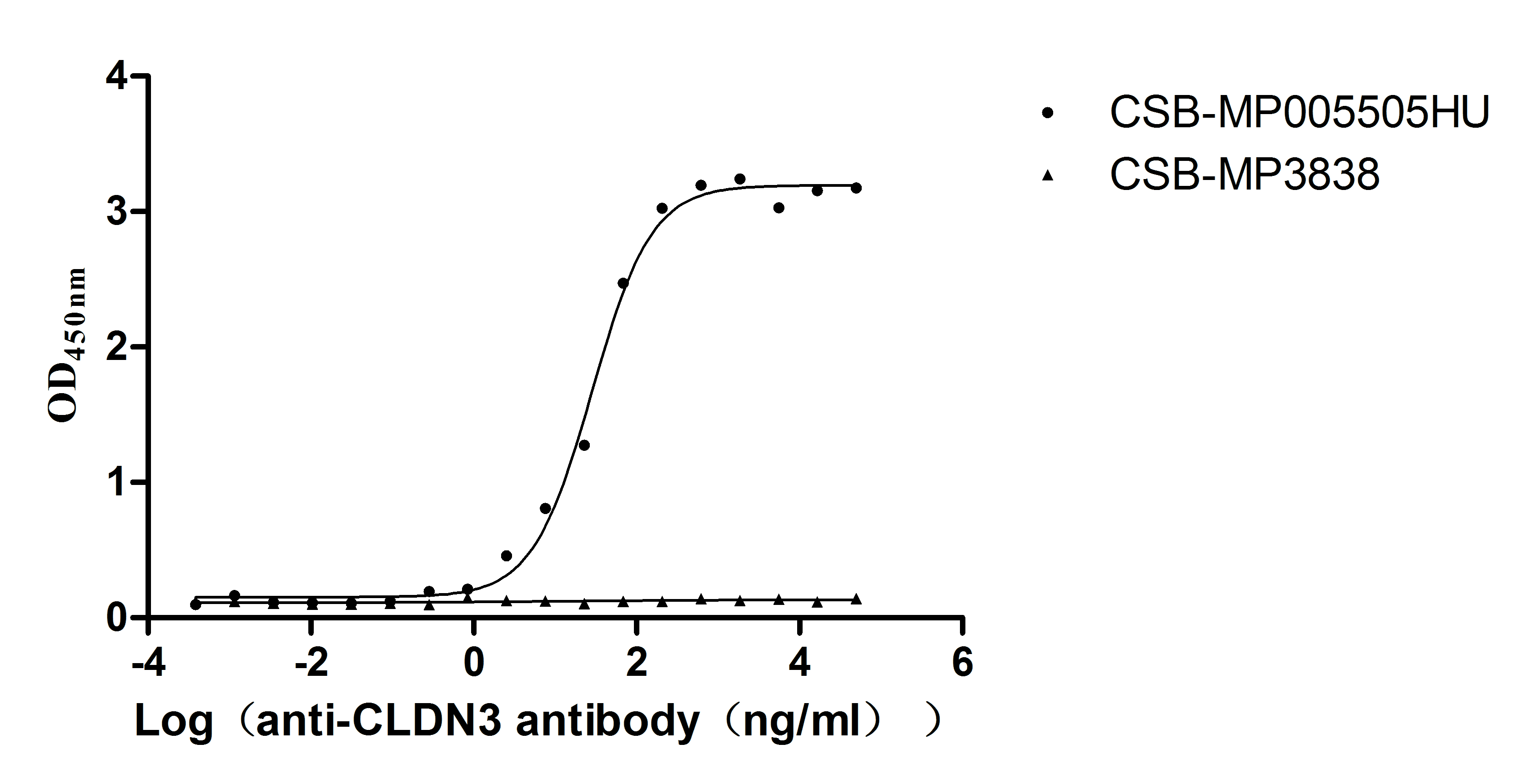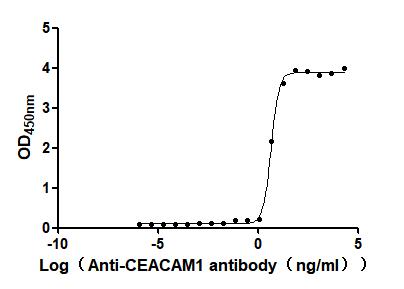Recombinant Human Actin filament-associated protein 1-like 2 (AFAP1L2), partial
-
中文名称:Recombinant Human Actin filament-associated protein 1-like 2(AFAP1L2) ,partial
-
货号:CSB-YP836667HU
-
规格:
-
来源:Yeast
-
其他:
-
中文名称:Recombinant Human Actin filament-associated protein 1-like 2(AFAP1L2) ,partial
-
货号:CSB-EP836667HU
-
规格:
-
来源:E.coli
-
其他:
-
中文名称:Recombinant Human Actin filament-associated protein 1-like 2(AFAP1L2) ,partial
-
货号:CSB-EP836667HU-B
-
规格:
-
来源:E.coli
-
共轭:Avi-tag Biotinylated
E. coli biotin ligase (BirA) is highly specific in covalently attaching biotin to the 15 amino acid AviTag peptide. This recombinant protein was biotinylated in vivo by AviTag-BirA technology, which method is BriA catalyzes amide linkage between the biotin and the specific lysine of the AviTag.
-
其他:
-
中文名称:Recombinant Human Actin filament-associated protein 1-like 2(AFAP1L2) ,partial
-
货号:CSB-BP836667HU
-
规格:
-
来源:Baculovirus
-
其他:
-
中文名称:Recombinant Human Actin filament-associated protein 1-like 2(AFAP1L2) ,partial
-
货号:CSB-MP836667HU
-
规格:
-
来源:Mammalian cell
-
其他:
产品详情
-
纯度:>85% (SDS-PAGE)
-
基因名:AFAP1L2
-
Uniprot No.:
-
别名:Actin filament-associated protein 1-like 2; AF1L2_HUMAN; AFAP1-like protein 2; afap1l2; CTB-1144G6.4; KIAA1914; XB130
-
种属:Homo sapiens (Human)
-
蛋白长度:Partial
-
蛋白标签:Tag type will be determined during the manufacturing process.
The tag type will be determined during production process. If you have specified tag type, please tell us and we will develop the specified tag preferentially. -
产品提供形式:Lyophilized powder
Note: We will preferentially ship the format that we have in stock, however, if you have any special requirement for the format, please remark your requirement when placing the order, we will prepare according to your demand. -
复溶:We recommend that this vial be briefly centrifuged prior to opening to bring the contents to the bottom. Please reconstitute protein in deionized sterile water to a concentration of 0.1-1.0 mg/mL.We recommend to add 5-50% of glycerol (final concentration) and aliquot for long-term storage at -20℃/-80℃. Our default final concentration of glycerol is 50%. Customers could use it as reference.
-
储存条件:Store at -20°C/-80°C upon receipt, aliquoting is necessary for mutiple use. Avoid repeated freeze-thaw cycles.
-
保质期:The shelf life is related to many factors, storage state, buffer ingredients, storage temperature and the stability of the protein itself.
Generally, the shelf life of liquid form is 6 months at -20°C/-80°C. The shelf life of lyophilized form is 12 months at -20°C/-80°C. -
货期:Delivery time may differ from different purchasing way or location, please kindly consult your local distributors for specific delivery time.Note: All of our proteins are default shipped with normal blue ice packs, if you request to ship with dry ice, please communicate with us in advance and extra fees will be charged.
-
注意事项:Repeated freezing and thawing is not recommended. Store working aliquots at 4°C for up to one week.
-
Datasheet :Please contact us to get it.
相关产品
靶点详情
-
功能:May play a role in a signaling cascade by enhancing the kinase activity of SRC. Contributes to SRC-regulated transcription activation.
-
基因功能参考文献:
- present study demonstrated that the expression of XB130 is elevated in CRC cells. Loss of XB130 was associated with decreased invasion and migration of CRC cells, possibly as a result of EMT inhibition. PMID: 28849225
- Our results suggest that dissociation between XB130 and Tks5 may facilitate lateral cell migration via XB130/Rac1, and vertical cell migration via Tks5/Cdc42. These molecular mechanisms will help our understanding of airway epithelial repair and regeneration. PMID: 27835612
- these observations suggest that XB130 may be a novel molecular marker and potent therapeutic target for prostate PMID: 27509056
- Results suggest that Tks5, similar to XB130, plays a role in cell proliferation and cell survival and that the interaction between XB130 and Tks5 appears to be critical for regulation of Src-mediated cellular homeostasis. PMID: 26446840
- XB130 is a mediator for nicotine-derived nitrosamine ketone-induced cell migration through its translocation to cell motility related microfilamentous cellular structures. PMID: 25980441
- XB130 could be useful as a prognostic marker of recurrence-free and overall survival in invasive ductal breast cancer, as well as for the response to chemotherapy. PMID: 26191231
- This is the first study to reveal that XB130 overexpression may be related to the prediction of metastasis potency and poor prognosis for osteosarcoma patients PMID: 26045762
- Results showed significant interaction between variants at TERF1 and AFAP1L2 loci. Given the key role of TERF1 in telomere biology and its physical interaction with AFAP1L2, these results support a role for telomere dysfunction in melanoma development. PMID: 25892537
- High XB130 expression is associated with pancreatic ductal adenocarcinoma. PMID: 24581082
- XB130 enhances cell motility and invasiveness by modulating the epithelial-mesenchymal transition-like process. PMID: 24387290
- High nuclear expression of XB130 is associated with esophageal squamous cell carcinoma. PMID: 22805860
- XB130 could promote growth of cancer cells by regulating expression of tumor suppressive miRNAs and their targeted genes. PMID: 23527086
- XB130 is a substrate of multiple protein tyrosine kinases, and it can regulate cell proliferation and survival through modulating selected down-stream signals of PI3K/Akt pathway PMID: 22928011
- reduced XB130 protein expression is a prognostic biomarker for shorter survival and a higher recurrence rate in patients with gastric cancer PMID: 22927913
- Protein expression of XB130 is not associated with the postoperative prognosis of patients with hepatocellular carcinoma. PMID: 22190283
- These observations suggest that the expression of XB130 in these cancer cells may affect cell proliferation and survival by controlling the expression of multiple genes, especially transcription regulators. PMID: 21224076
显示更多
收起更多
-
亚细胞定位:Cytoplasm.
-
组织特异性:Detected in spleen and thyroid, and at lower levels in kidney, brain, lung and pancreas.
-
数据库链接:
Most popular with customers
-
Recombinant Human Claudin-3 (CLDN3)-VLPs (Active)
Express system: Mammalian cell
Species: Homo sapiens (Human)
-
Express system: Mammalian cell
Species: Homo sapiens (Human)













